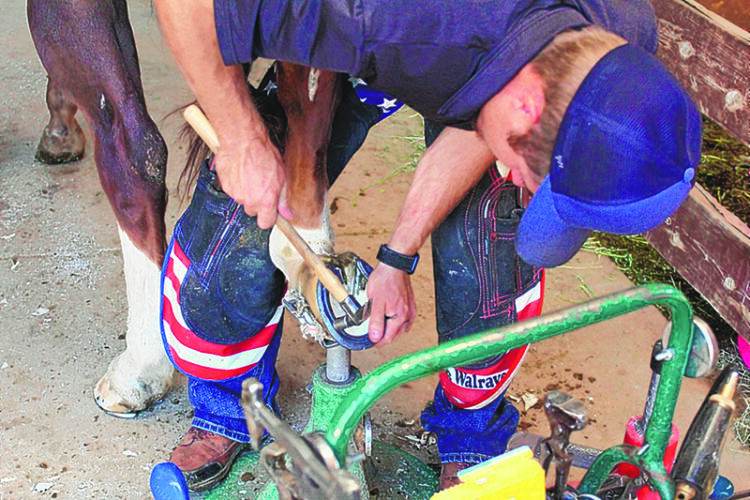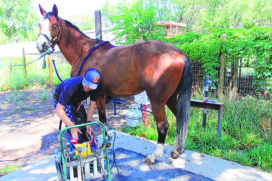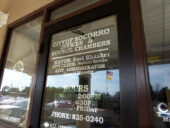
Rodee Walraven nails the shoe on the hoof of a horse. Juan Baeza | El Defensor Chieftain
The profession of a horseshoer, or farrier as many know it, tends to get a bad rep amongst the horse community. In the United States, it’s not really regulated.
“Anyone can pick up a rasp or a pair of nippers and just start trimming and shoeing horses,” said Rodee Walraven, who has been shoeing for more than a decade.
He says there are still great shoers out there, they are just harder to find.
Walraven grew up on a ranch in Datil with his parents and an older brother.
“Since I can remember, I always stuck around the horseshoers that would come to the ranch,” he said. “I remember looking forward to that day, and I would just follow them around, hand them their tools or nails. As I got older, both my brother and I started shoeing ourselves.”
Walraven went to a horseshoeing school in Tucson, Ariz. After the program was over, he shadowed a more experienced horseshoer. Walraven is thankful for this time as this is where he learned the most.
“When we were first starting, he asked me, ‘Do you want to shoe for a living? Or do you just want to shoe for yourself?’ I said, ‘Well, I’m trying to do it for a living.’ The next day, we went and put shoes on 28 horses.”
The experience was eye opening for Walraven — from shaping the shoe to fitting the shoe.
“Getting underneath them and actually doing it is where you really learn all the ins and outs — how every horse is different,” Walraven said. “The schooling and the book are of course important. To really understand how the hoof functions, you have to do it.”
The process is usually about the same. Walraven walks the horse a bit to see the way it moves. This also protects him. If the horse is already sore before he shoes it, he can quickly point this out to the owner.
Walraven watches the horse stand to recognize where it is most comfortable and how the horse distributes its weight. From here, he begins to clean and trim as necessary.
He then picks a horseshoe that is the correct size for the animal. He fits it and then starts to mold it so the shoe fits correctly. After shaping the horseshoe, he nails it to the hoof.

Rodee Walraven, a local farrier, reaches for a different size shoe. Juan Baeza | El Defensor Chieftain
Horseshoeing is tremendously physically demanding work. It’s really hard on the lower back.
“It’s not easy,” Walraven said. “I’ve questioned myself quite a bit when I was starting. There was nothing but pain and aching. You work muscles that you don’t typically work.”
Walraven says you begin to learn how to get comfortable and how to grab a leg in a way that helps you.
“It took me like the first five years to accommodate physically and build some calluses,” he said.
When it comes to the shoeing, it’s all up to the horse — from the way it stands to the way it moves. These are all things that Walraven, as the horseshoer, has to look at before starting to shoe the horse.
“You have to go off their confirmation. There is a mapping of the shoe, of course, but every horse is a little different. You can’t go around giving the same old trim to every horse,” Walraven said.
Sometimes horses are dealing with special problems. Whether they are pigeon-toed, knees pointing out or maybe they have calf knee, a situation where the horse sits back and puts most of its weight in the back of its hoofs. In these situations, Walraven has owners get x-rays to see what is really going on.
The x-rays allow him to see which parts the horse may need more support for and how his trim can affect the horse.
Walraven has reached a point in his career where he is on a constant schedule that allows him to do around 30 horses a week.
“I am very fortunate; I have a set list of clients and I am not taking any new clients,” he said.
When Walraven first started shoeing, he found himself working with undisciplined horses.
“As you make your way up the ladder in this business, you can’t really give yourself that luxury of turning them down. It was really tough; it took a long time,” he said. “There were times when a really undisciplined horse had me questioning if this was worth doing.”

Horseshoer Rodee Walraven is rasping down the top of the hoof, so the horse doesn’t have anything where the hoof could get caught.
Juan Baeza | El Defensor Chieftain
Undisciplined horses can seriously injure a horseshoer and themselves in the process.
“Though it’s part of the business, I now turn down horses that can put me in danger. It’s not worth sustaining a serious injury over 150 bucks,” he said.
Thirty horses a week is the magic number. Walraven can still feel good and fatigue won’t take over.
“I had to find that number, because in order for me to do a good job, I can’t be dog tired. If I do too many, I know I’m not going to shoe the last one the same way I shoed the first horse,” Walraven said.
Walraven is extremely grateful for the craft as it has allowed him to create his successful business.
“I am just grateful, the lord blessed me with this ability, and it has opened so many doors for me,” he said. “I am self-employed and I have built my days in ways for me to spend as much time with my family. I come early in the afternoons and play with my boys. I am truly blessed.”
Walraven is thankful for the trust that his clients put in him with their horses.
“This is one of those professions that you can’t do just because it’s good money — you have got to care for the animals in order to be doing this,” he said. “To me, there is nothing more rewarding than seeing your client and that horse performing or moving around comfortably.”
Read more stories in the 2022 Cowboy Country in the Special Sections page on our site.





















